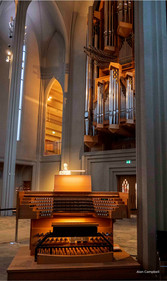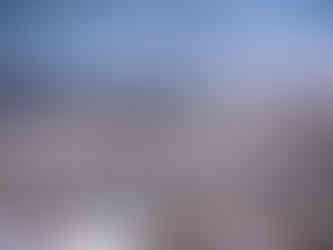It's Easy to Reach Hallgrimskirkja
- Alan Campbell
- Jan 26, 2023
- 5 min read
It’s easy reaching the top of Hallgrimskirkja Church tower, almost easy as it is to find the church in the first place.
Its exterior resembles a bird flying toward the heavens, with wings spread out closely to the ground and then swooping up toward its center tower.

Others say the architect drew inspiration from Iceland’s many volcanoes. At 245 feet in height, it is the tallest building in downtown Reykjavik and the largest church in the country.
Just inside the front door is located the elevator that transports you eight stories upward, inside that center tower. Once there you’ll find yourself behind the four immense clock faces on each side of the tower.
(While there is no fee to enter the church, there is one to go up the tower, 1,200 Icelandic Krona. Roughly $8.50 US. Tickets are purchased at the gift shop, just a few steps beyond the elevator.)
It’s an easy walk up the stairs one additional floor to the top of the tower. Look down through the narrow openings in the concrete walls and you’ll discover the most beautiful views in all of Reykjavik.
From the front of the church, to the northwest, there’s a clear view of the city’s downtown. Turn to the northeast and look down upon Faxaflói Bay with snow covered mountains in the not-too-far distance.

Businesses and hospitals are in view out the southeast window and more residential areas appear from the southeast side, including a row of colorfully painted side-by-side structures in reds, yellows, blues and greens.
On a warm, calm day you might spend a great deal of time up there, picking out an endless number of sites from perch on high. On other days, say like the one on which I happened to be there, it will probably be a rather abbreviated visit.
Winds on the ground were racing at 20 mph with gusts far more than that. People quite literally were leaning into the wind, and often being blown back, as they worked to reach the front door.
Once those winds hit the side of the church they join forces, whipping up the side and through the open windows at the top. It was everything I could do to get near the windows in front, where the wind was blowing its hardest. No one stayed for more than a few minutes.
I took a quick video to give you some idea of what it was like up at the top during that wind. (It does repeat in the middle.):
If you happen to be in Reykjavik on a day such as that, never fear, the clock faces on the eighth floor are enclosed with clear window panels along the bottom from which you can view out without feeling like you’re going to be blown through the opposite side windows.
By the way, the clocks chime every 15 minutes so there’s a pretty good chance you’ll be up there when that happens.
austere - adjective
aus·tere ȯ-ˈstir also -ˈster
1: stern and cold in appearance or manner
an austere Puritan
2: markedly simple or unadorned
an austere office
Austere might be the appropriate word to describe the church’s sanctuary. Other than the massive and beautiful pipe organ above the entrance there is little adornment Mostly shades of concrete gray. Even the light brown pews are covered with gray upholstery.

A tall statue of Jesus, receiving the Holy Spirit after being baptized in the Jordan, sits just inside the entrance door. The one, small stained-glass window is tucked away in a corner.
The front altar is of a similar design as the church, gray and set simply with a cross, four candles and two flower vases. The font and pastor’s pulpit, raised just above the height of the pews and sitting to the right, are the only things edging on some sense of drama.
It’s exactly what I imagine a Lutheran church should look like. Simple, but not plain, with few frivolities, and still amazingly beautiful.
For what it’s worth, I have some familiarity with the Lutheran church, so I’m not speaking out of turn. My wife was Lutheran, we were married in the Lutheran church, Darling Daughter was confirmed in the Lutheran church and I was active in the church.
Hallgrimskirkja was designed in honor of Icelandic minister and poet, Hallgrímur Pétursson, author of Passion Hymns. Written in the 1600s, the hymns continue to be sung and read during Lent in Icelandic homes today.
Iceland’s State Architect Guðjón Samúelsson began work on designing the church in 1937. As alluded to in the introduction above, he drew his inspiration from the country’s geological features, including the basalt columns created by its many volcanoes and glaciers.
Actual construction did not begin until 1945 and, unfortunately, Samúelsson did not live to see it completed, dying in 1950.
Architects Hörður Bjarnason and Garðar Halldórsson picked up the torch from there and worked to maintain Samúelsson’s vision. It wasn’t until 1986, more than 40 years after it had begun, that the church was finally consecrated.
Hallgrimskirkja Pipe Organ
Not surprisingly, in the largest church in Iceland sits the largest pipe organ in the country as well.

Constructed by Johannes Lais of the Orgelbau Klais company in Bonn, Germany, it’s 50-feet tall, contains 5,275 pipes and weighs 25 tons.
Fun fact, the company also installed the organ in Birmingham, United Kingdom’s Symphony Hall and many others around the world.
The sanctuary’s ceiling, 244-feet high in the center, has a conical shape said to be reminiscent of Viking helmets, providing incredible acoustics for the organ and church choirs.
(I've posted two videos at the bottom of this page of the pipe organ in action and then of singer Bjork performing inside the church).
Leifur Eiríksson Statue
Outside the church, you can’t miss the statue of Leifur Eiríksson. Those of us in the US are more familiar of him by the name, Leif Ericson, believed to be the first European to set foot on North America, 500 years or so before Christopher Columbus.

It weighs 50 tons and, surprise, it was a gift from the United States. The US presented it to Iceland in 1930 to honor the 1000-year anniversary of Iceland’s Althingi, the oldest parliament in the world.
Good news, if you’d like to see the statue yourself, I have a deal for you, there’s an identical copy at Mariners Museum in Newport News, Virginia.
The original casts used in making the statue are being kept by the Smithsonian Institution. The Smithsonian loaned them to Iceland so that it could make a copy for the 1939 World’s Fair in New York City. After the fair it was relocated to Mariners Museum.
Oh, and, if you you’re wondering about when the statue was donated vs. when the church was constructed, yes, the statue was there before the church. The statue’s original location was near the water’s edge but it was moved to its current spot in 1932, 13 years before they even began construction on the church.
_________________
**I allow use of my photos through Creative Commons License. I'm not looking to make money off this thing. I only ask you provide me with credit for the photo by noting my blog address, alansheaven.com, or a link back to this page.


























Comments